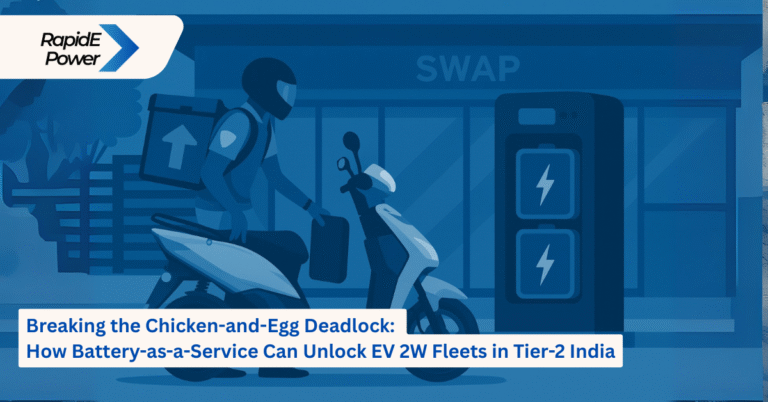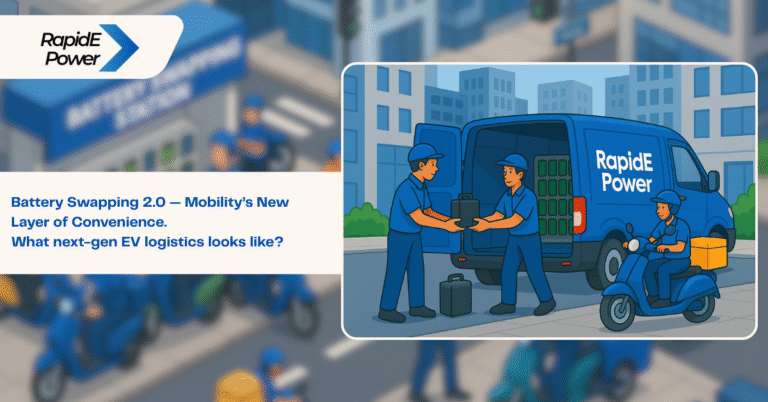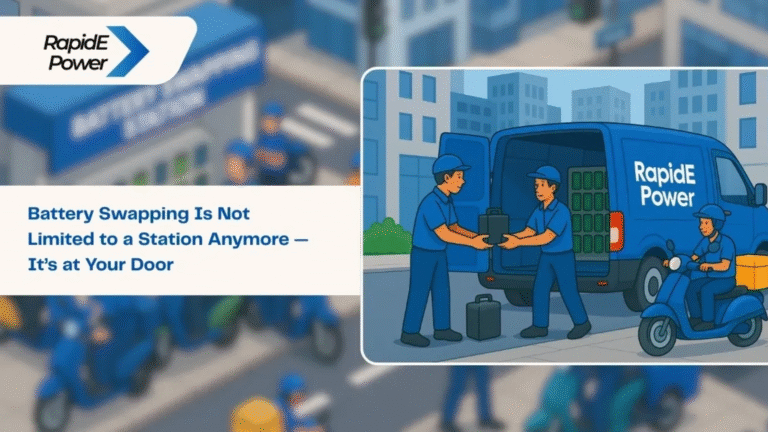
- India crossed ~2.0 million EVs in FY25; electric two-wheelers (E2Ws) alone did ~1.14 million—the workhorse segment for last-mile logistics.
- Gig workforce is set to triple to ~23.5 million by 2029–30, creating sustained demand for predictable, low-downtime energy services.
- Battery pack prices fell to a global average ~$115/kWh in 2024, improving BaaS unit economics (higher cycles, lower $/kWh).
- E2W TCO already beats petrol: ~₹1.48/km vs ~₹2.46/km—advantage compounds for high-utilization riders.
- India targets 30% EV penetration in new sales by 2030; states are adding targeted support (e.g., Tamil Nadu’s ₹20,000 e-scooter subsidy for gig workers).
Together, these signals make Battery-as-a-Service (BaaS)—especially for E2W/E3W gig fleets—one of the most compelling mobility infra bets in India’s next decade.
Why BaaS—and why now?
Two structural shifts are converging:
(1) last-mile delivery keeps scaling, and
(2) India’s EV mix is dominated by two- and three-wheelers.
E2Ws captured ~58% of EV sales in FY25, with retail volumes of ~1.14 million, up ~21% YoY—evidence that the country’s “EV curve” begins with scooters and bikes, not cars.
On the demand side, India’s gig and platform workforce is projected to reach ~23.5 million by 2029–30 (from 7.7 million in 2020–21). A significant portion sits in mobility and delivery, where vehicle uptime and per-km energy cost drive earnings. Riders doing dozens of drops a day simply can’t afford hours of plug-in downtime—they need energy in minutes, not hours.
On the cost side, the battery learning curve re-accelerated: average pack prices dropped to $115/kWh in 2024 after hitting $139/kWh in 2023. Lower capex per kWh and maturing LFP chemistries (long cycle life, robust safety envelope) improve the swap pack’s lifetime revenue per rupee. Policy tailwinds add confidence. India’s national goal is 30% EV share of new sales by 2030, and states are layering incentives; for example, Tamil Nadu announced a ₹20,000 e-scooter subsidy plus insurance support for gig workers in August 2025.
What BaaS solves (and how money is made)
BaaS unbundles the battery from the vehicle. Operators own/manage packs and provide riders or fleets a pay-per-swap, subscription, or hybrid plan. Revenue scales with kWh throughput and swaps per day, not vehicle sales.
- Downtime → minutes: Swapping restores range in minutes vs hours of plug-in charging—critical for high-utilization couriers (global courier studies show ~100 km/day is typical; India’s dense urban logistics often matches that order of magnitude).
- Predictable opex: E2W TCO is already lower than petrol—~₹1.48/km vs ~₹2.46/km; BaaS makes it even more predictable by converting energy into a flat per-km/per-swap fee.
- Utilization = margins: Higher daily swaps lift kWh utilization per pack, accelerating payback.
India’s swapping footprint is no longer experimental. 2,600+ stations were already on ground by 2024 across major players; Battery Smart (2W/3W focused) reported ~3.5 million swaps per month in 2024–25; Gogoro operates at ~12 million swaps per month globally—useful scale benchmarks for India.
The policy & safety backbone (de-risking the asset)
- Battery safety (AIS-156): India tightened traction battery norms after 2022 incidents. AIS-156 (Amendment 3/4) mandates that in a thermal-propagation test triggered by a single-cell runaway, there must be no fire/explosion, and packs must provide an audio-visual warning at least 5 minutes before any hazardous propagation—plus logging/traceability and other safeguards. For investors, compliance isn’t optional; it’s your downside protection.
- Stations & power: The Ministry of Power (Jan 19, 2025) issued guidelines for installing and operating charging and battery swapping stations; typical station loads of ~30–80 kW are cited in practitioner briefs—important for sizing connections and opex.
- End-of-life & residual value: Battery Waste Management Rules, 2022 create EPR obligations for collection, recycling/refurbishment. Proper EPR execution and second-life sales enhance terminal value and reduce regulatory risk.
- Macro target: India’s 30% EV new-sales goal by 2030 is reiterated in the latest NITI Aayog publications—this is the policy north star every infra investor should underwrite against.
Moving Forward…
BaaS converts India’s largest EV segments (E2W/E3W) into an energy-services annuity with utilization-driven operating leverage. It rides long-term policy momentum (30% EV by 2030), falling battery $/kWh, superior TCO vs petrol, and an expanding gig economy whose earnings hinge on uptime. The model’s winners will be those who execute on dense networks, safety/compliance, unit-economic discipline, and B2B relationships—all areas where RapidE Power is building for scale.



